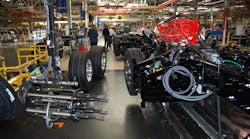Class 8 net orders reached 22,800 units in March, according to data tracked by research firm FTR Transportation Intelligence – slightly above expectations and much higher than a year ago for the third consecutive month.
Though Class 8 net order volumes were essentially flat month-over-month, Don Ake, FTR’s vice President of commercial vehicles, noted they were up 41% year-over-year in March with order backlogs now close to where they were a year ago.
He added that orders are forecast to stay close to this level through May, similar in trend to 2013, with Class 8 orders over the past six months now “annualizing” to a Class 8 build rate of 243,000 units per year. “March orders are reflective of a more normal Class 8 market in a moderate, freight-driven upcycle,” Ake said in a statement.
“Replacement cycles are now getting back into a more traditional pattern,” he added. “This reflects growing fleet confidence as they see freight growth returning after a difficult 2016. There is renewed optimism in the industry.”On the medium-duty front, ACT Research added that preliminary data indicates North American net orders for Class 5-7 trucks increased to 24,200 units in March, up 5% from February and 3% compared to March 2016.
While those comparisons were modest, Kenny Vieth, ACT’s president and senior analyst, noted that March’s preliminary numbers represented the biggest month for medium-duty orders in just over nine years or since February 2008, he said.
Meanwhile, back on the Class 8 front, FTR's Ake described the current order trend as a “reserved, contained market upswing,” meaning it will be easier for OEMs to increase builds gradually and that prices won’t fluctuate as much.
“It provides some market stability,” he explained. “It is good for the industry and a good sign for the economy in the second half of the year.”
However, Michael Baudendistel, vice president of the transportation and logistics research group at Stifel Capital Markets, recently expressed an “uneasy feeling” about the ongoing increase in Class 8 build rates, largely due to worries regarding a potential “mid-year lull” in orders.
“The large fleets are not buying much equipment given the lack of increases in freight rates that would typically coincide with a period of sustained strength in equipment orders,” he explained in a research update.Baudendistel added that, according to analysis conducted by two different experts at ACT Research working independently, the industry currently is currently oversupplied with trucks by about 6% to 7%, largely due to the “very strong production volumes” in 2014 and 2015.
“Typically, improvements in freight rates lead an uptick in equipment orders; that has not been the case this time with freight rates flattish and with spot rates still considerably below contract rates,” he emphasized.
“Therefore, the recent uptick in orders have come more in anticipation of a recovery in the freight markets rather than reacting to an improvement in the freight markets,” Baudendistel pointed out. “That gives us concern regarding whether the recent order pattern is sustainable, or whether increases in 2017 production estimates … will simply come at the expense of 2018 production.”





